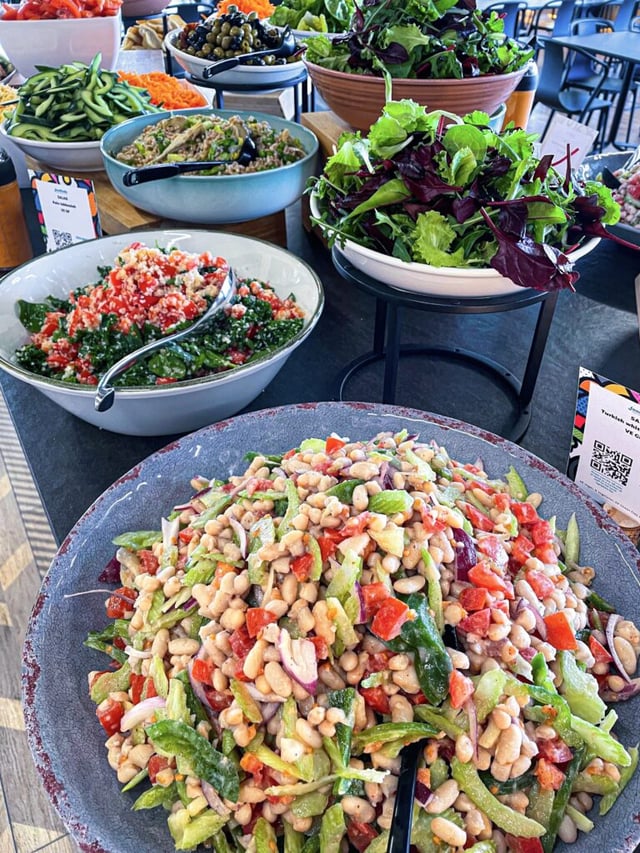First, let’s clarify; when we say “delivered catering” or “delivered caterers” we mean office lunches cooked at a central production kitchen and transported to client offices.
This differs from a “food aggregator” that collects food from different restaurants and delivers it to the workplace. Both services offer delivery and eliminate the need for a kitchen in the office. The key difference is where the food is prepared and who has responsibility for it.
Straight-up, delivered catering feeds offices better than aggregators. Of course, it’s what we WOULD say. There’s no getting around the fact that we have a bias (being delivered-in office caterers ourselves).
However, our conviction in the delivered catering model isn’t without good reason. After all, we’d have chosen to be aggregators if we believed offices were better served that way.
Delivered caterers: tried and tested
Our learnings are taken from experience. Fooditude has been running a delivered catering model in London since 2005. In that time, we’ve worked with clients with individual needs and requirements. Many of our clients previously used aggregators before they discovered us.
Time and time again, we’ve heard our clients’ stories about aggregators causing hassle for office and facilities managers. Some issues we’ve heard about include disorganisation with orders, multiple deliveries, late deliveries, and dealing with packaging waste. Not to mention the lack of healthy food options on aggregator sites.
Cristina Covello, Head of Strategic Growth at Fooditude, shared some of her learnings from her experiences working directly with clients,
“Aggregated foodservice is an excellent first step if a company wants to explore giving complimentary meals to their in-office teams. This system can work like a charm for smaller offices until the headcount exceeds 20-30 employees. When teams grow, office and facilities managers become overwhelmed with issues, most noticeably dealing with order mix-ups and keeping office sites clean after service”
For more information about how Fooditude can feed your workplace, get in touch.

Aggregators: “they keep disappointing my staff”
Companies start offering food at work to incentivise and reward staff for a job well done. However, we often hear that the food offering doesn’t have the desired effect for companies using aggregators.
The key here is consistency. The delivered catering model provides reliability because the food is made by the same chefs in the same kitchen daily. Menus are cohesive, seasonal and varied. At Fooditude, a food development team researches and refines our recipes before making them for the client. Whilst aggregators might offer a variety of food ‘brands’ to choose from, delivered catering offers a more consistent dining experience throughout the year.
What's even in these office lunches?
Restaurants that the aggregators use tend not to have a sound labelling system or complete ingredients and allergens listed on the meal packaging. This makes it easier for people to take the wrong meal or eat something they either didn’t want – or, more alarmingly, are allergic to.
On the other hand, delivered caterers like us employ a full-time health & safety manager and kitchen administrator who ensure meals are labelled, and allergens are correct. We provide a complete ingredient list with every delivery and QR code on our labels so that people can double-check ingredients before they eat.
Where the focaccia is my lunch?
Deliveries, when late, incomplete or incorrect, can result in disappointed diners. We’ve heard many horror stories from prospective clients looking to ditch their aggregator that orders arrive way past lunchtime – disappointing their teams – or worse, their clients.
Would you believe that we’ve never had a late delivery in all our years of service? Well, it’s true. Workplace experience and facilities managers can sleep easy knowing exactly what meals will be delivered – and when. When feeding offices, reliability is critical to keeping staff happy and well-fed. Delivered catering is a simplified process as a result of more centralised operations. We are making and delivering the food, so there is less chance of miscommunication. Things can go wrong when aggregators liaise between multiple restaurants and their delivery teams or subcontractors.
Aggregators: a messy business
Aggregated foodservice tends to generate excessive packaging and food waste that creates more work for the teams responsible for the office. Uneaten food and used packaging all need to be cleared after service – and the buck often falls to workplace teams who have other jobs to do.
Delivered catering avoids ‘takeaway’ meal rubbish by delivering meals in reusable containers and serving meals with proper plates and cutlery. After service, our delivery drivers collect our crockery, taking it back to the kitchen to be washed and used again (and again and again).

Sense and sustainable catering
Aggregators put their trust in the restaurant kitchens that they list. However, a vast network of independent kitchens makes tracking sustainability standards difficult. If all your food is made by one provider in one kitchen, like it is at Fooditude, then visibility on sustainability action is easier to monitor. For example, do you know what sustainability accreditations your aggregator demands of their partners?
A significant benefit of a central kitchen and food service partner is that sustainability accreditations are straightforward as there are fewer to track. Good examples of sustainability accreditations include Planet Mark, which measures and reports on Fooditude’s carbon emissions. The Sustainable Restaurant Association also provides a sustainability framework for food-service businesses to follow – of which we’re proud to be members. With everything in one place, it becomes possible for Fooditude to monitor, assess and report our sustainability data.
Simplicity for more sustainable meals
Another benefit is that delivered caterers have free reign to choose ingredients from ethical and sustainable suppliers and to set minimum animal welfare standards. We can also work with you on your preferences or accommodate your sustainability policies! We’re not saying smaller kitchens can’t be ambitious about their CSR (see SILO London). However, the dispersed and complex model aggregators use makes tracking this difficult.
Talking about dispersed brings us to our next point! Delivered-in catering from one central kitchen helps to reduce food miles after the meal has been cooked. All the meals are made at one site, and it only takes a single journey to ensure all the food arrives on-site, on time. Meanwhile, aggregators collect food from multiple dispersed kitchens.
Which is best? Delivered caterers or aggregators
So what do you think? Have we proven that delivered catering services win over food aggregators? Food aggregators have their place in the market, that’s for sure. If you’ve got a team of ten people you’d like to treat with lunch – aggregators will fulfil your demand.
However, feeding large teams in the office isn’t as easy as it sounds as staff numbers grow. With many mouths to feed, workplaces can do without the risks of an aggregator picking up food from multiple kitchens or making multiple deliveries. What you need are one kitchen and one delivery. Now, doesn’t that sound simple?
Still hungry for more?
If you’re craving to try out Fooditude’s seasonal menu (for free), let’s make it happen:




